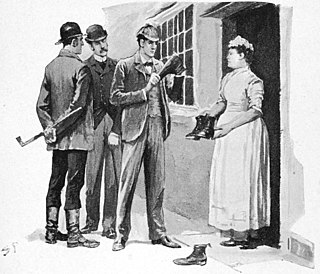
Detective fiction is a subgenre of crime fiction and mystery fiction in which an investigator or a detective—whether professional, amateur or retired—investigates a crime, often murder. The detective genre began around the same time as speculative fiction and other genre fiction in the mid-nineteenth century and has remained extremely popular, particularly in novels. Some of the most famous heroes of detective fiction include C. Auguste Dupin, Sherlock Holmes, and Hercule Poirot. Juvenile stories featuring The Hardy Boys, Nancy Drew, and The Boxcar Children have also remained in print for several decades.

A whodunit or whodunnit is a complex plot-driven variety of detective fiction in which the puzzle regarding who committed the crime is the main focus. The reader or viewer is provided with the clues to the case, from which the identity of the perpetrator may be deduced before the story provides the revelation itself at its climax. The investigation is usually conducted by an eccentric, amateur, or semi-professional detective.

Crime fiction, detective story, murder mystery, mystery novel, and police novel are terms used to describe narratives that centre on criminal acts and especially on the investigation, either by an amateur or a professional detective, of a crime, often a murder. It is usually distinguished from mainstream fiction and other genres such as historical fiction or science fiction, but the boundaries are indistinct. Crime fiction has multiple subgenres, including detective fiction, courtroom drama, hard-boiled fiction, and legal thrillers. Most crime drama focuses on crime investigation and does not feature the courtroom. Suspense and mystery are key elements that are nearly ubiquitous to the genre.
The "locked-room" or "impossible crime" mystery is a type of crime seen in crime and detective fiction. The crime in question, typically murder, is committed in circumstances under which it was seemingly impossible for the perpetrator to commit the crime or evade detection in the course of getting in and out of the crime scene. The crime in question typically involves a crime scene with no indication as to how the intruder could have entered or left; for example, a victim found deceased in a windowless room that is sealed from the inside at the time of discovery. Following other conventions of classic detective fiction, the reader is normally presented with the puzzle and all of the clues, and is encouraged to solve the mystery before the solution is revealed in a dramatic climax.

Mystery is a fiction genre where the nature of an event, usually a murder or other crime, remains mysterious until the end of the story. Often within a closed circle of suspects, each suspect is usually provided with a credible motive and a reasonable opportunity for committing the crime. The central character is often a detective, who eventually solves the mystery by logical deduction from facts presented to the reader. Some mystery books are non-fiction. Mystery fiction can be detective stories in which the emphasis is on the puzzle or suspense element and its logical solution such as a whodunit. Mystery fiction can be contrasted with hardboiled detective stories, which focus on action and gritty realism.

Crime is a typically 19th-, 20th- and 21st-century genre, dominated by British and American writers. This article explores its historical development as a genre.
The police show, or police crime drama, is a subgenre of procedural drama and detective fiction that emphasizes the investigative procedure of a police officer or department as the protagonist(s), as contrasted with other genres that focus on either a private detective, an amateur investigator or the characters who are the targets of investigations. While many police procedurals conceal the criminal's identity until the crime is solved in the narrative climax, others reveal the perpetrator's identity to the audience early in the narrative, making it an inverted detective story. Whatever the plot style, the defining element of a police procedural is the attempt to accurately depict the profession of law enforcement, including such police-related topics as forensic science, autopsies, gathering evidence, search warrants, interrogation and adherence to legal restrictions and procedure.

Michael Joseph Connelly is an American author of detective novels and other crime fiction, notably those featuring LAPD Detective Hieronymus "Harry" Bosch and criminal defense attorney Mickey Haller. Connelly is the bestselling author of 31 novels and one work of non-fiction, with over 74 million copies of his books sold worldwide and translated into 40 languages. His first novel, The Black Echo, won the Mystery Writers of America Edgar Award for Best First Novel in 1992. In 2002, Clint Eastwood directed and starred in the movie adaptation of Connelly's 1997 novel, Blood Work. In March 2011, the movie adaptation of Connelly's novel The Lincoln Lawyer starred Matthew McConaughey as Mickey Haller. Connelly was the President of the Mystery Writers of America from 2003 to 2004.

In criminology, a calling card is a particular object sometimes left behind by a criminal at a scene of a crime, often as a way of taunting police or claiming responsibility. The name is derived from the cards that people used to leave when they went to visit someone's house and the resident was absent. A calling card can also be used as an individual's way of telling someone they are alive after they have run away or disappeared without revealing themselves or having direct contact with that person. It is often left at a bed side table while the person is asleep, at the living room floor and sometimes even at a grave yard if they know the times someone goes to visit their loved ones. However, some criminals choose not to leave a calling card, as it may be used by authorities or detectives to trace the criminal, and eventually arrest them.

4.50 from Paddington is a detective fiction novel by Agatha Christie, first published in November 1957 by Collins Crime Club. This work was published in the United States at the same time as What Mrs McGillicuddy Saw!, by Dodd, Mead. The novel was published in serial form before the book was released in each nation, and under different titles. The US edition retailed at $2.95.
An inverted detective story, also known as a "howcatchem", is a murder mystery fiction structure in which the commission of the crime is shown or described at the beginning, usually including the identity of the perpetrator. The story then describes the detective's attempt to solve the mystery. There may also be subsidiary puzzles, such as why the crime was committed, and they are explained or resolved during the story. This format is the opposite of the more typical "whodunit", where all of the details of the perpetrator of the crime are not revealed until the story's climax. The first such story was R. Austin Freeman's The Case of Oskar Brodski published in Pearson's Magazine in 1912.
The Golden Age of Detective Fiction was an era of classic murder mystery novels of similar patterns and styles, predominantly in the 1920s and 1930s.
Nicholas Austin Pizzolatto is an American writer, producer and director. He is best known for creating the HBO crime drama series True Detective.

Stuart MacBride is a Scottish writer, most famous for his crime thrillers set in the "Granite City" of Aberdeen and featuring Detective Sergeant Logan McRae.

Crime Unlimited is a 1935 British crime film that was made as a Quota quickie. It was directed by Ralph Ince. The film marked the English-language debut of Lilli Palmer.

Cadfael is a British mystery television series, broadcast on ITV between 1994 and 1998, based on The Cadfael Chronicles novels written by Ellis Peters. Produced by Central, it starred Derek Jacobi as the medieval detective and title character, Brother Cadfael. The complete series was released on DVD on 24 August 2009. The series aired in the United States as part of the Mystery! series.

The Missing and the Dead is the ninth instalment in the bestselling Detective Sergeant McRae series of crime novels set in Aberdeenshire from Stuart MacBride.

Cold Granite is the debut novel written by Stuart MacBride. It features Detective Sergeant Logan McRae as its central character, who works for Grampian Police in Aberdeen, Scotland. Logan McRae went on to feature in a series of books which became a bestseller series for MacBride.

The Sussex Downs Murder is a 1936 detective novel by the British writer John Bude. It is the second novel in a series featuring Superintendent Meredith. He has transferred from the Lake District to the Sussex Constabulary based in Lewes between the novels. Much of the novel takes place around the Chanctonbury Ring. In 2014 it was reissued by the British Library Publishing as part of a group of republished crime novels from the Golden Age of Detective Fiction.













